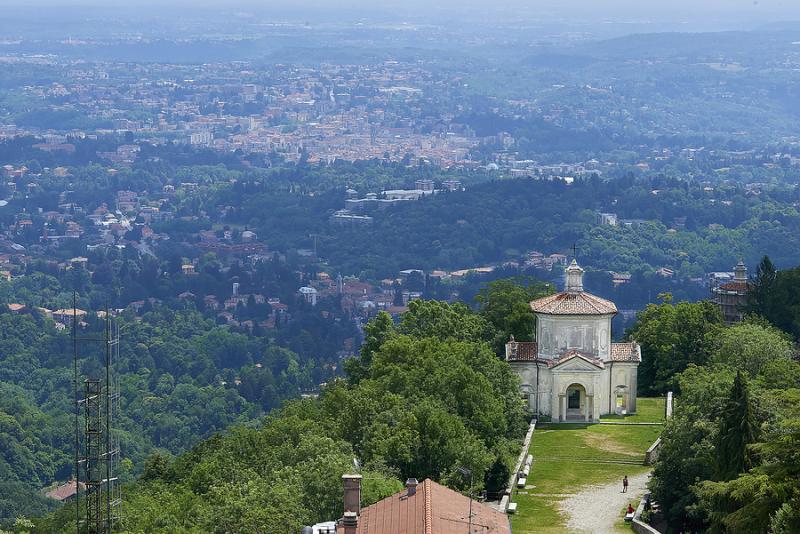UNESCO Sites of Italy: Sacri Monti of Piedmont and Lombardy
ITA:

A Unesco serial site not many are familiar with, the nine Sacri Monti (Sacred Mountains) of Italy are groups of chapels created in the late 16th and 17th centuries dedicated to different aspects of the Christian faith. They are located in northern Italy, in the regions of Piedmont and Lombardy.
“In addition to their symbolic spiritual meaning, they are of great beauty by virtue of the skill with which they have been integrated into the surrounding natural landscape of hills, forests and lakes”, writes Unesco, which inscribed them into the World Heritage list in 2003.
The Sacri Monti also house works of art such as paintings and statues depicting scenes from the life of Christ, Mary and the Saints; besides their artistic value, they are also seen as a form of catechism told through images.
Some of the most gifted late Renaissance and Baroque artists of the Lombard tradition worked on the Sacri Monti, which were built as places of prayer in Europe for pilgrims who could not make it to the Holy Land.
The first to be built for this reason was the Sacred Mountain of Varallo in 1480, which became a model for other Sacri Monti that followed, although each evolved with their own unique art and architecture.
Distributed along the slopes of hills, these architectural complexes invite visitors to follow a physical and spiritual path, a pilgrimage in other words through a series of monumental stations that make the natural space sacred. Thus, the Sacri Monti represent a sort of sacralization of the landscape, extraordinarily integrated into the surrounding nature of forests, lakes and hills.
The Sacri Monti of Italy had a profound influence on subsequent developments elsewhere in Europe. Between World War II and the 1980s, they lost their popularity, until they were restored and safeguarded to become a religious and cultural destination, as well as places of inter-religious confrontation, research and conferences.
Un sito seriale Unesco che non molti conoscono, i nove ‘Sacri Monti’ sono gruppi di cappelle creati tra la fine del XVI° e il XVII° secolo dedicati a diversi aspetti della fede cristiana. Si trovano nel nord Italia, nelle regioni del Piemonte e della Lombardia.
"Oltre al loro significato simbolico spirituale, essi sono di grande bellezza in virtù dell'abilità con cui sono stati integrati nel paesaggio naturale circostante di colline, foreste e laghi", scrive l'Unesco, che li ha inseriti nella lista del Patrimonio Mondiale dell’Umanità nel 2003.
I Sacri Monti ospitano anche opere d'arte come dipinti e statue raffiguranti scene della vita di Cristo, di Maria e dei Santi; oltre al loro valore artistico, essi sono anche visti come una forma di catechismo raccontata attraverso le immagini.
Alcuni dei più dotati artisti del tardo Rinascimento e del Barocco della tradizione lombarda lavorarono ai Sacri Monti, che furono costruiti come luoghi di preghiera in Europa per i pellegrini che non potevano raggiungere la Terra Santa.
Il primo ad essere costruito per questo motivo fu il Sacro Monte di Varallo nel 1480, che divenne un modello per gli altri Sacri Monti che seguirono, sebbene ognuno si sia evoluto con una propria arte e architettura.
Distribuiti lungo le pendici delle colline, questi complessi architettonici invitano i visitatori a seguire un percorso fisico e spirituale, in altre parole un pellegrinaggio attraverso una serie di stazioni monumentali che rendono sacro lo spazio naturale. Pertanto, i Sacri Monti rappresentano una sorta di sacralizzazione del paesaggio, straordinariamente integrati nella natura circostante di foreste, laghi e colline.
I Sacri Monti d'Italia ebbero una profonda influenza su altri costruiti successivamente in Europa. Tra la seconda guerra mondiale e gli anni '80, perdettero la loro popolarità, fino a quando non furono restaurati e salvaguardati e così diventare una destinazione religiosa e culturale, nonché luoghi di confronto interreligioso, di ricerca e conferenze.











